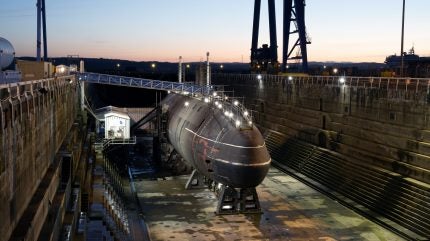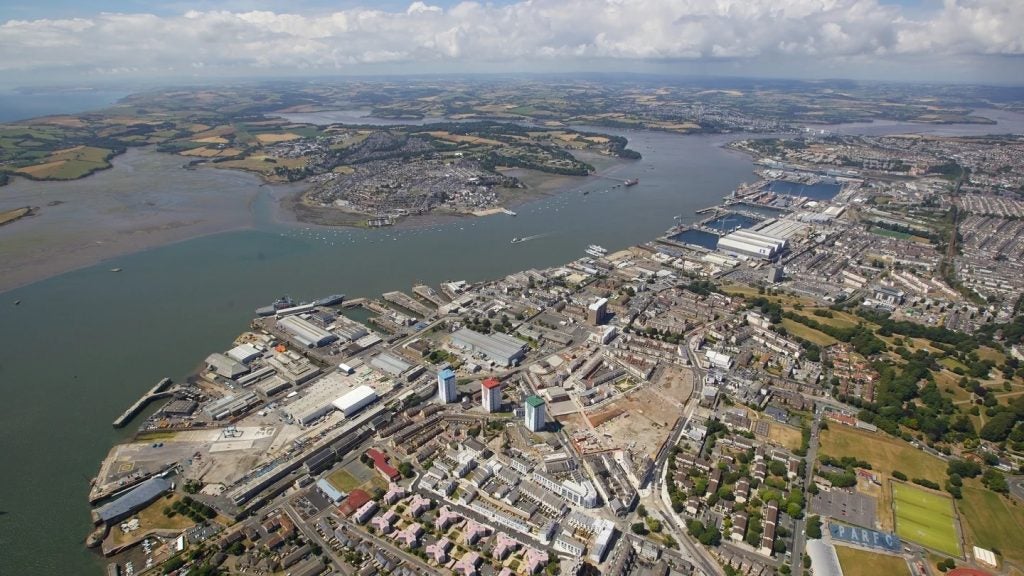
The UK’s ongoing work to dismantle the former nuclear-powered attack submarine HMS Swiftsure remains “on track” to complete in 2026, while plans are underway to determine the next two boats to be sent for recycling ahead of a possible contract award in 2025.
The recycling of HMS Swiftsure is being used as a demonstrator for the UK Ministry of Defence’s (MoD) Submarine Dismantling Project (SDP), intended to develop a UK sovereign capability to fully dispose of decommissioned nuclear-powered submarines at Babcock’s Rosyth facility.
UK Minister for the Armed Forces Luke Pollard stated on 18 October 2024, that the dismantling of HMS Swiftsure was “on track”, with the process serving to “inform a baseline approach and schedule” for all current decommissioned Royal Navy submarines.
“We are currently working with Babcock in Rosyth to plan for the next two boats in sequence, with a view to being on contract next year,” Pollard said.
It is thought likely that HMS Valiant, lead boat of the Valiant-class nuclear-powered attack submarines (SSN), will be one of the two boats placed on contract for recycling in 2025.
Delivering the SDP
In 2023 the dismantling of HMS Swiftsure got underway at Babcock’s shipyard in Rosyth, with the initial timeline scheduling a completion end the end of 2026.
Around 90% of components, including steel, can be reused for recycling in the process, which will all be undertaken at the Rosyth site. Commissioned into service in 1972, HMS Swiftsure was the lead boat in the Swiftsure-class SSNs and operated until its decommissioning in 1992.
The MoD’s SDP is managed by the Submarine Delivery Agency (SDA) and is responsible for potential dismantling 27 nuclear submarines; 22 of which are decommissioned and have left service, while five currently continue to be operated by the Royal Navy.
Following two public consultations, the UK MoD selected a three-stage approach to dismantling, having also engaged with Nato partners, likely to gather information on processes and recycling practices.
In Nato, the US and France are the only two other operators of nuclear-powered submarines, although countries such as Italy, Sweden, Germany, and Norway, among others, utilise conventionally powered diesel-electric submarines.

Babcock’s Royal Naval Dockyard at HMNB Devonport has undergone an extensive modernisation programme to includes improvements to submarine sustainment facilities and the ability to defuel decommissioned nuclear-powered submarines.
Early in 2024 it was reported by Naval Technology that the naval reactor dismantling facility, located at 14 Dock inside HMNB Devonport, was due to begin operations later the same year.
Babcock expected that one decommissioned nuclear submarine will be able to be dismantled per year, although once nuclear contaminated material had been removed at the 14 Dock facility, the remaining hull or casing of the submarine could be scrapped outside of the Royal Naval Dockyard.
UK submarine recapitalisation
The outcome of the work being undertaken to dismantle HMS Swiftsure will in turn provide a better understanding in how to expand the process to HMNB Devonport, where the majority of the Royal Navy’s decommissioned submarines are housed. In total, seven of the submarines intended to be recycled in Rosyth, with the remaining 20 in Devonport.
According to a 2019 investigation by the UK’s National Audit Office into submarine defuelling and dismantling, the MoD had spent an estimated £500m ($651m) since 1980 on storing and maintaining its retired nuclear submarines.
The UK currently has five of the latest Astute-class SSNs in service or commissioned (Astute, Ambush, Artful, Audacious, and Anson), along with a single remaining Trafalgar-class SSN, HMS Triumph.
A sixth Astute class, HMS Agamemnon, was recently lowered into the water at the BAE Systems submarine yard in Barrow-in-Furness, while a seventh, HMS Agincourt, is still under construction.
Each of the Astute-class SSNs cost between £1.3-1.6bn and are expected to service for at least 25 years with the Royal Navy.
In addition, the RN operates four Vanguard-class SSBNs (Vanguard, Victorious, Vigilant, Vengeance), which will be replaced by the incoming Dreadnought-class submarines, with the first-in-class currently in manufacture in Barrow-in-Furness.
The UK has also begun the process to replace the Astute class with the planned AUKUS-SSN being developed for use by the Royal Navy and Australia. The class is effectively an evolution of the UK’s SSNR (Submersible Ship Nuclear Replacement) concept originally intended as the Astute-class replacement.
The AUKUS SSN is likely to feature the under-development Pressurised Water Reactor 3 (PWR3) that will be installed on the Dreadnought-class SSBNs and feature a vertical launch system from which to fire embarked surface and land attack munitions.




